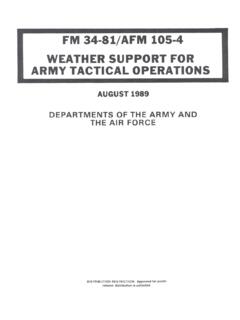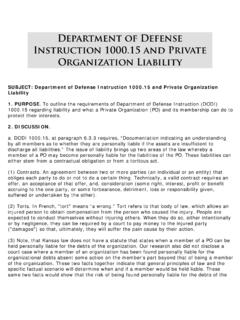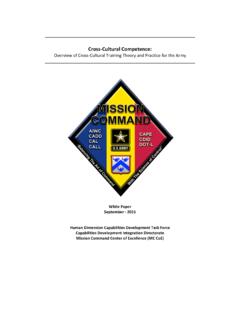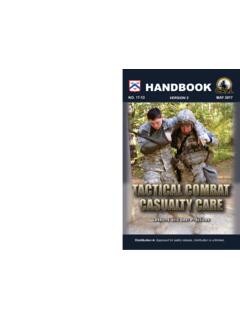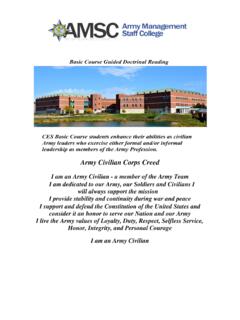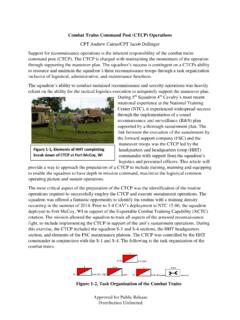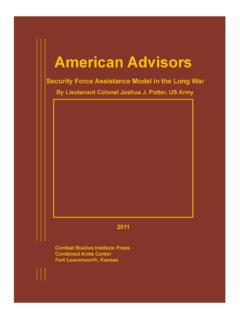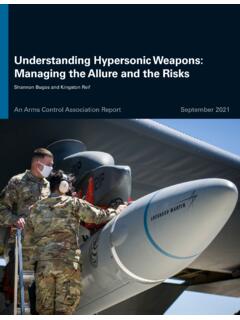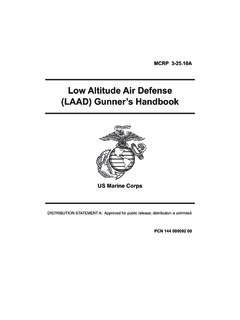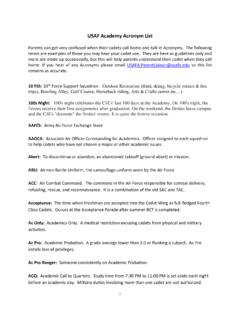Transcription of Combat Skills for Weapon Status Weapon Ranges Navigation ...
1 Combat Skills forSmall Unit LeadersGTA XX-XX-XXXDATE TBDA pproved for Public ReleaseDistribution is unlimited Ensure controls are in place to prevent mishandling of weapons in living and sleeping areas. Supervise weapons clearing at all times whether ammunition is present or not. Ensure range safety program is in place. Ensure vehicle-mounted weapons are cleared prior to mounting or Soldiers Treat every Weapon as if it s loaded. Handle every Weapon with care. Identify the target before you fire Never point the muzzle at anything. Keep the Weapon on safe and your finger off the trigger until ready to and ClearNoneWeapon StatusLeadersSTOPPAGESA stoppage is a failure of an automatic or semi-automatic firearm to complete the cycle of operation. Immediate action involves quickly applying a possible correction to reduce a stoppage without troubleshooting.
2 Use SPORTS to apply immediate action: Slap gently upward on the magazine to ensure that it is fully seated and the magazine follower is not jammed Pull the charging handle fully to the rear Observe the ejection of a live round or expended cartridge Release the charging handle; do not ride it forward Tap the forward assist assembly to ensure the bolt is closed Squeeze the trigger and try to fire the rifleWEAPONS CONTROL STATUSThe three levels of weapons control Status outline the conditions, based on target identification criteria, under which friendly elements can engage. The platoon leader sets and adjusts the weapons control Status based on friendly and enemy disposition, and clarity of the situation. Generally speaking, the higher the probability of fratricide and friendly fire, the more restrictive the weapons control Status . The three levels, in descending order of restrictiveness are: weapons HOLD: Engage only if engaged or ordered to TIGHT: Engage only targets positively identified as or forwardEmptysafeOffPreparedLoad MagazineMagazine InForwardEmptySafeOffReady / SafeMake ReadyRound Chambered/Loaded in Feed Tray ForwardLocked/ Locked BackSafeOffWeapon RangesNavigationDuring planning and preparation for tactical movement, leaders analyze the terrain from two perspectives.
3 First, they analyze the terrain to see how it can provide tactical advantage to friendly and enemy forces. Second, they look at the terrain to determine how it can aid Navigation . Leaders identify areas or terrain features dominating their avenue of approach, as these can become possible intermediate and final example route plan is shown above. A leader chooses check points and designates legs to control movement. Leaders control movement by stating a movement formation and technique for each leg based on the threat. Planning Considerations- Plan for the Object Rally Point (ORP) to be out of sight, sound, and small arms range of the objective- Plan to move 1 3 KM per hour depending on terrain, formation, and technique- Plan primary approach and return routes along with an alternate routeHand & Arm SignalsReportsRadio OperationsSoldiers at all echelons of the Army employ tactical radios across all phases of operations in support of all warfighting functions.
4 The SINCGARS ASIP allows operators to quickly set up, load frequencies, and Panel Radio RT -1523 EWeapon SystemMaximum Effective RangeMaximum RangeSymbolM16 A2M4M249 TripodM240B BipodM240B TripodM2MK19M203 / M32060-mm M720 HE Mortar81-mm M821 HE Mortar120-mm M934 HE Mortar7200M5608M3490M400M2212M6764M3725M 3600M3600M3600 MAreaPointAreaPointAreaPointAreaPointAre aPointAreaPointAreaPointAreaPointAreaPoi nt800M550M600M500M800M600M1000M600M800M6 00M1100M800M1500M600M2212M1500M350M150 MWeapon SystemM249 BipodM249M240BM2MK19 Sustained (RPM)Rapid (RPM)Cyclic (RPM)50100850100200650-9504040450-550325 -3754060 Engagement TechniquesPoint: Concentrating effects of fire against a specific, identified target Area: Distributing effects of fire over an area for numerous or not obvious enemy positions Simultaneous: Rapidly mass the effects of their fires or to gain fire superiorityAlternating: Pairs of elements continuously engage same point/area target one at a timeObserved: Direct one element to engage; other elements observe and prepare to engageSequential: Elements of a unit engage the same point/area target in arranged sequenceTime of Suppression: Period when enemy position or force is required to be suppressedRecon by Fire: Engage possible enemy locations to elicit a tactical response (return fireor movement)LEGAZIMUTH /DISTANCEKEY INFORMATIONLeg 1: SP 1 to CKP in woodline east of the hardball at the base of the 2: CKP 1 to CKP2.
5 -Stay on south side of dirt secondary road. Continue movement to the large church at 3: CKP 2 to Stay on east side of hill 25. Continuemovement to the boulders at the / 500m030 / 1800m319 / 450mO: LimitedA: HWY : Hill mass west of : : : UnlimitedA: Dirt TrailK: Hill 18 southeast of : : : UnlimitedA: Dirt TrailK: Hill 25 west of : : CHECK POINTRP RELEASE POINT SP START POINT M METERSJoin me, follow me, or come forwardLine FormationHalt (Stop forward movement)Take CoverCease FireMap CheckFreeze (Cease all Movement)Assemble or rallyPace CountIncrease speed, double timeWedge formationEnemy in sightColumn formationVisual Signals: See TC Single channel (SC) frequency into ASIPa. Prepare to perform taskb. Load SCFREQc. Store SCFREQd. Prepare tocommunicate1. Obtain proper FREQ from ANCD or SKL(Load CUE FREQ only if directed)*2. Set Controls.**COMSEC to PT, mode to SCFCTN to Z-FH, TST, and then to load (LD)CHAN to MAN, CUE, or 1-61.
6 Press FREQ2. Press CLR2. Enter five-digit SC FREQP ress STO (within 7 seconds)1. Repeat step b-1 for each FREQ needed2. Set: FCTN to SQ ONRT displays reads: GOOD(or see unit mainter)Display shows 00000 or 30000 Display shows (_____)Display shows SC XXXXXD isplay blinks once (data is stored)(As directed by net control station[NCS] or unit SOPL oading of SC FREQ is complete*Only NCS and aternate NCSS will load a CUE frequency.**RT settings for ASIP are set via the MENUWhen identifying a communications plan for an operation, it is critical to account for a primary, alternate, contingency, and emergency (PACE) method of communication. The PACE concept is a valuable tool to ensure there is a back up communications plan in place in case the primary plan fails. An example PACE plan is outlined below: Primary JNN Alternate TACSAT Contingency High Frequency Emergency - SINCGARSS ubtaskActionResultA leader uses reports to communicate with higher elements and receive information from subordinate elements to answer priority information requirements (PIR) and drive operations.)
7 Reports are sent in accor-dance with (IAW) unit TACSOP or per the commander s guidance. Common ReportsSPOT REPORT (SPOTREP): Used to report intelligence or Status regarding events that could have an immediate and significant effect on current and future operations. Line 1 Date and Time (DTG) Line 2 Unit (unit making report) Line 3 Size (size of detected element) Line 4 Activity (detected element activity at DTG of report) Line 5 Location (UTM or grid coordinate for element activity or event) Line 6 Unit (detected element unit, organization, or facility) Line 7 Time (DTG of observation) Line 8 Equipment (equipment of element observed) Line 9 Assessment (apparent reason or purpose of activity observed) Line 10 Narrative (additional info required to clarify report)ACE REPORT:: Used during reorganization to determine unit Status . Can be communicated with a red, amber, or green Status IAW unit Amount per Soldier and Weapon systemCasualties Number of casualties by type (litter, ambulatory)Equipment Status of key equipment5-Point Contingency Plan (GOTWA): Used when a leader or other individuals separate from the main : Going where is the leader going?
8 O: Others are others going with the leader and who?T: Time (duration) how long will the element be gone?W: What procedures do we take if the leader fails to return?A: Actions what actions does the departing element and main body plan to execute on enemy contactSLANT REPORT: Used to give the commander accurate and routine information regarding the Status of critical personnel and equipment. Line 1 Date and Time (DTG) Line 2 Unit (unit making report)Line 3 CDR S Info Req (Commander s Information Requirements)Line 4 Equipment (type and amount)Line 5 Personnel (type and amount)Line 6 Narrative (additional information required to clarify report)9-Line MEDEVAC RequestMedical Evacuation (MEDEVAC): The process of moving any person who is wounded, injured, or ill to and/or between medical treatment facilities while providing en route medical MEDEVAC Request FormatLine 1 Location of pickup siteLine 2 Radio frequency, call sign, and suffix of requesting personnelLine 3 Number of patients by precedence.
9 Urgent loss of life or limb within 2 hours Priority loss of life or limb within 4 hours Routine evacuate within 24 hoursLine 4 Special equipment required, as applicable (none, hoist, stokes litter [litter basket], jungle penetrator)Line 5 Number of patients by type (litter, ambulatory)Line 6 Security of pickup site: N No enemy troops P Possible enemy troops in area E Enemy troops in area (approach with caution) X Enemy troops in area (armed escort required)Line 7 Method of marking pickup site: A. Panels; B. Pyro; C. Smoke; D. None; E. OtherLine 8 Patient nationality and Status : A. US Military; B. US Civilian; C. Non-US Military; D. Non-US Civilian; E. Enemy Prisoner of WarLine 9 NBC Contamination (Wartime): C.
10 Chemical; B. Biological; R. Radiological; N. NuclearLine10 Terrain Description (Peacetime)Casualty Evacuation (CASEVAC): Nonmedical units use this to refer to the movement of casualties aboard nonmedical vehicles or aircraft without en route medical care.*If medical evacuation platforms (ground and/or air) are available, casualties should be evacuated on these conveyances to ensure they receive proper en route medical Combat Casualty CareEvaluation of a casualty is necessary to identify and treat all life-threatening conditions and other serious wounds. Rapid and accurate evaluation of the casualty is the key to providing effective first aid. Use MARCH as the inspection process for the proper order of treatment and PAWS for additional casualty care issues:Massive Hemorrhage Airway Respirations Circulation Head Injury / HypothermiaPainAntibioticsWoundsSplintin gTactical Combat Casualty Care (TC3) can be divided into three phases: Care under fire, Tactical field care, and Tactical evacuation under fire limits the care you can provide: Return fire as directed or required before providing medical treatment.
